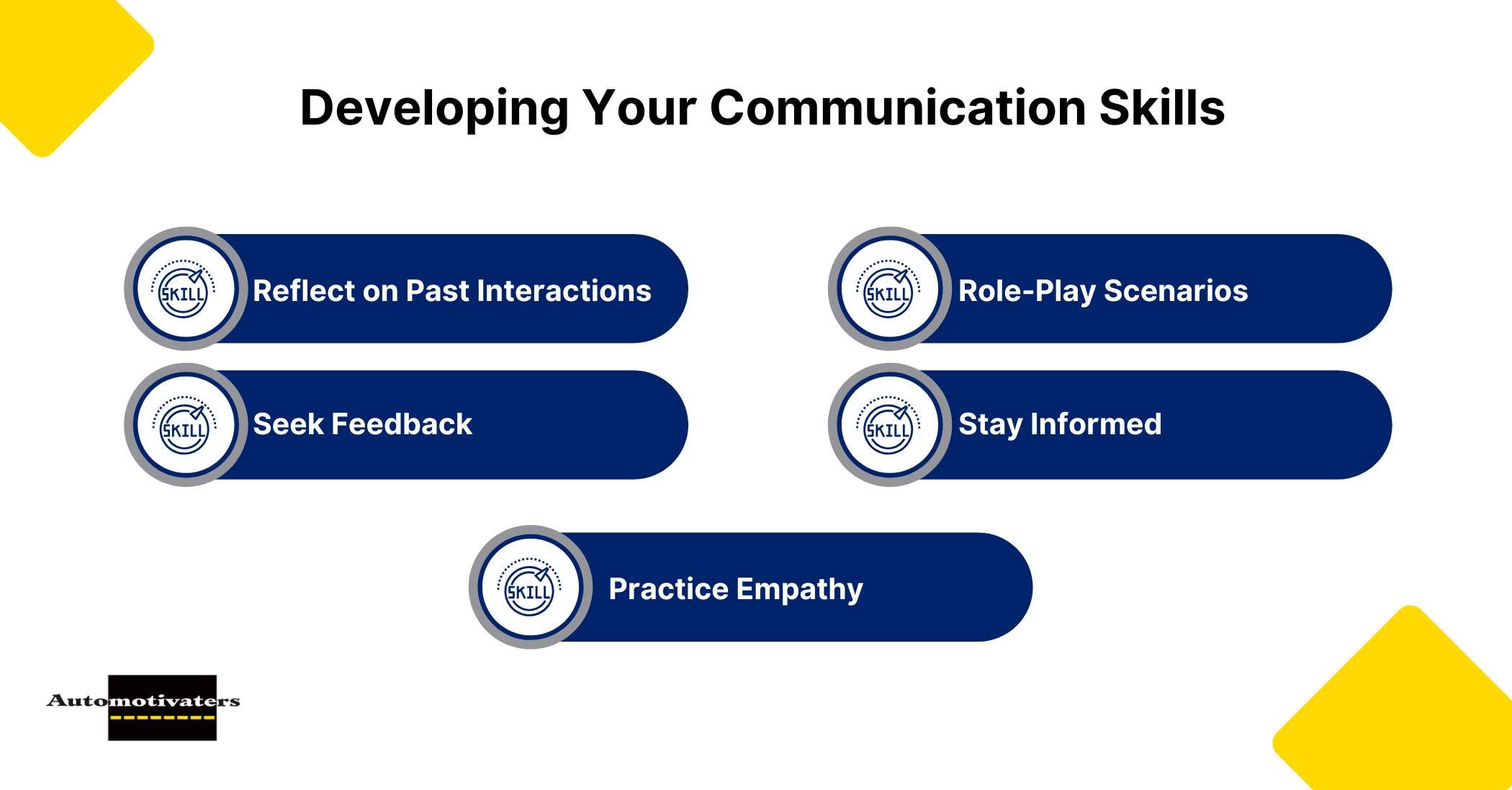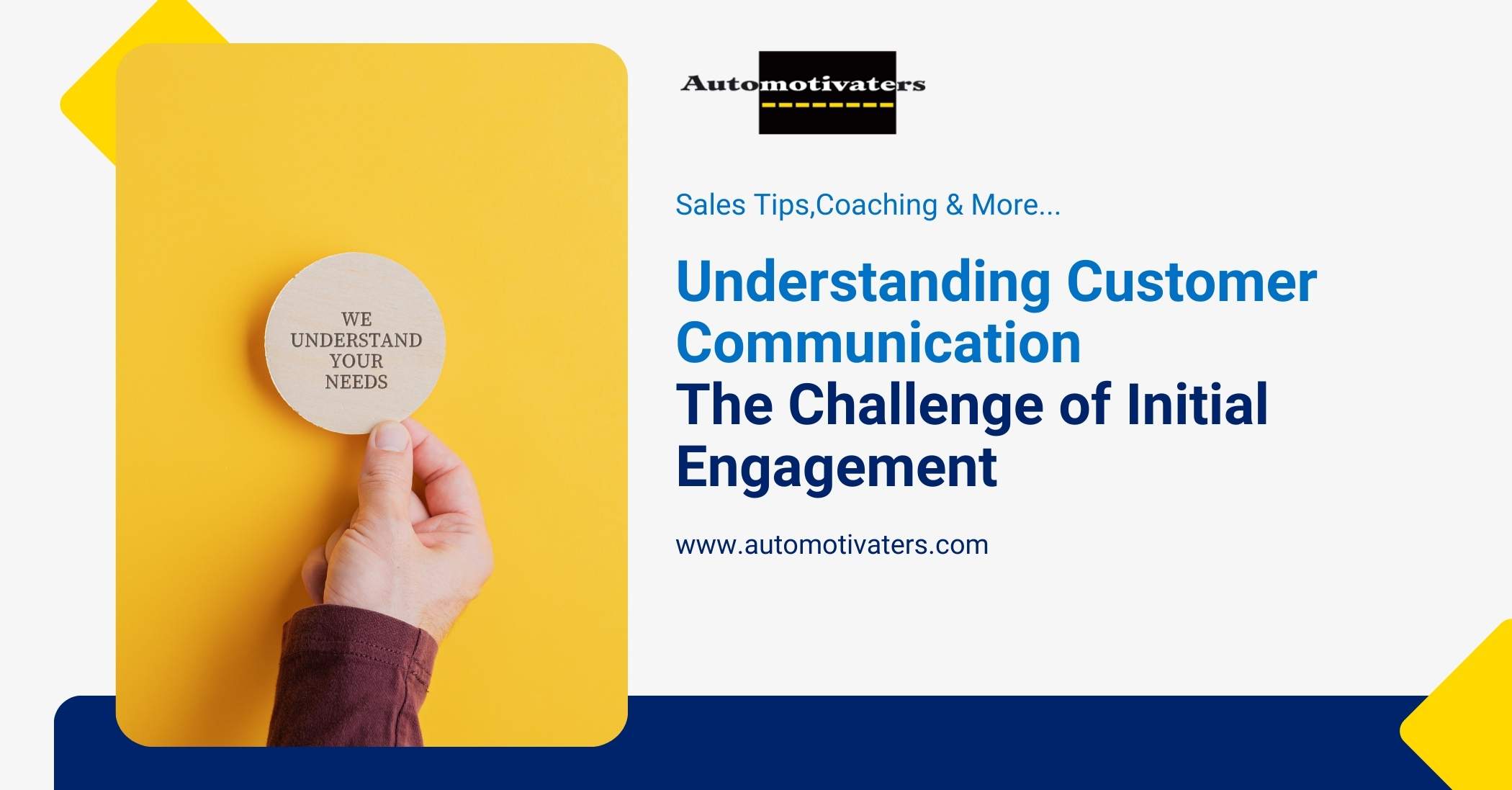In the rapidly evolving automotive market, understanding customer communication is not just advantageous; it’s essential. As we navigate the complexities of customer interactions, we often encounter a common challenge: initial engagement.
Customers may present stalls, such as “we’re just looking” or “not much time—not buying today.” While these statements may seem insurmountable, what if I told you that they conceal a wealth of valuable insights just waiting to be discovered?
It’s time to break down the communication layers and transform these initial engagements into meaningful conversations that lead to successful outcomes.


Understanding the Layers of Communication
When customers approach, their words are only the surface of a deeper narrative. As sales professionals, we must delve deeper and interact with the underlying narrative. Let’s break down a typical stall:
- Text: “We’re just looking.”
- Emotion: “I’m uncomfortable and a little afraid of being rushed by a pushy salesperson.”
- Intent: “I will keep you at a distance to see if I like and trust you before I engage.”
- Relationship: “I don’t know this salesperson at all.”
- Goal: “I want that car.”
Recognizing these layers allows us to tailor our responses to address each aspect instead of merely reacting to the initial text.
The Challenge of Initial Engagement
Initial stalls can be daunting. It’s easy to feel rejected or discouraged when a customer seems unapproachable. However, this is precisely the point at which your opportunity presents itself.
Customers often approach a dealership with a mix of excitement and anxiety. They are eager to find their dream car but fear the pressure of a sales pitch. Recognizing this duality is key to transforming your approach.
Common Mistakes in Responding to Stalls
Understanding how to respond to stalls effectively can set you apart from the competition. Here are the two pitfalls to avoid:
The Passive Approach
Many sales professionals respond passively to stalls, thinking that giving the customer space is best. A typical response might be, “Okay, my name is John. I’ll leave you to look; ask me if you have any questions.”
While this response may seem polite, it does nothing to address the underlying emotions or intentions of the customer. Instead, it leaves them feeling unsupported and uncertain about who you are as a salesperson.


The Aggressive Approach
On the other end of the spectrum, some sales consultants adopt an aggressive approach. They ignore the emotional layers and attempt to steamroll the customer with a forceful invitation: “Well, that’s great; you’re just looking.
I’m the one who will help you find what you’re looking for. Come with me.” This approach can alienate customers, making them feel pressured and defensive.
The Importance of Addressing All Layers
To successfully engage customers, our responses must address all layers of communication. If we fail to reassure customers at the emotional level, they are unlikely to accept our guidance on the logical next steps toward their goal.
A Better Approach: Reassuring Response
So, how can we effectively engage our customers? The answer lies in crafting a reassuring response that acknowledges their feelings. An example of this might be:
“Certainly! There’s a lot to look at. Shopping for a car can be overwhelming, and I completely understand that you want to take your time. My name is John Smith, and I’m here to assist you with any information you need. Is there a specific vehicle you saw online that you’d like to check out?”
This response does several things:
- Acknowledges Overwhelm: By recognizing that the customer may feel overwhelmed, you create a connection.
- Builds Trust: Introducing yourself builds familiarity and trust, making them feel more comfortable.
- Offers Assistance: Inviting them to share their interests opens the door to a more engaging conversation.
Developing Your Communication Skills
Mastering this level of communication doesn’t come naturally to everyone. It requires practice, reflection, and a willingness to learn from each customer interaction. Here are some practical steps to develop your communication skills:


Reflect on Past Interactions
After each customer engagement, take a moment to reflect on what went well and what could be improved. Analyze your responses and identify where you could have addressed the emotional layer more effectively.
Role-Play Scenarios
Engage with colleagues in role-playing exercises to practice responding to typical stalls. This can help you become more comfortable with customer interactions and refine your approach.
Seek Feedback
Encourage your peers or supervisors to provide feedback on your communication style. Constructive criticism can illuminate blind spots and offer new strategies for engagement.
Stay Informed
Keep abreast of current trends in customer behaviour and preferences. Understanding what drives your customers will help you effectively tailor your communication to meet their needs.
Practice Empathy
Make a conscious effort to put yourself in your customers’ shoes. Consider their fears, desires, and motivations. This mindset will enable you to respond in a way that resonates deeply with them.
The Urgency of Adapting
In today’s automotive market, customers are more discerning than ever. They often visit only one or two dealerships before making a purchase decision.
This implies that every interaction holds significant importance. The urgency to adapt your communication style must be balanced. It’s not just about making a sale; it’s about building relationships that foster trust and loyalty.
When you effectively address the emotional layers of communication, you help the customer feel comfortable and position yourself as a trusted advisor. This dynamic can lead to not just a single sale but potentially lifelong customers who return to you for their future automotive needs.
Inspiring Action: Challenge Yourself
Now that you understand the importance of addressing the communication layers, it’s time to challenge yourself to act. Here are some actionable steps you can implement immediately:
Create a Reassuring Script
Draft a script that encompasses a variety of typical stalls you encounter. Ensure each response acknowledges the emotional layer while guiding the customer towards their goal.
Set Daily Goals
Commit to practicing your communication skills daily. Set specific targets, such as engaging with at least five customers in a way that addresses their emotional needs.
Track Your Progress
Keep a journal or log of your interactions. Note which approaches yield positive results and which do not. This ongoing reflection will help you refine your skills over time.
Engage with Mentors
Seek out mentors within your organization or industry. Learn from their experiences and insights on building trust and rapport with customers.
Embrace Continuous Learning
Attend workshops, webinars, or courses focused on sales communication and emotional intelligence. The more you invest in your development, the more confident and effective you will become.


Building Lasting Relationships
Ultimately, the goal of mastering customer communication is to build lasting relationships. When customers feel understood and valued, they are more likely to return for future purchases and recommend you to others. This is the foundation of a successful automotive sales career.
Consider this: every customer interaction is an opportunity to impact positively. When you take the time to engage with customers meaningfully, you are not just selling cars; you are building a community of satisfied customers who trust you and your expertise.
Conclusion: Your Call to Action
As you reflect on the layers of communication and the importance of addressing emotional needs, I challenge you to embrace this transformative approach wholeheartedly. The automotive industry is evolving, and so must your customer engagement strategies.
Take responsibility for your development and commit to mastering the art of customer communication. Remember that each interaction is an opportunity to learn, grow, and inspire. By approaching your customers with empathy and reassurance, you can pave the way for a successful career in automotive sales.
The time for action is now. Let go of passive or aggressive responses and step into the role of a trusted advisor. When you do, you won’t just sell cars; you’ll create lasting relationships that drive your success for years to come.
Embrace the challenge and watch how your communication skills transform your sales numbers and your entire career trajectory. The road to mastery is ahead—let’s drive it together!








